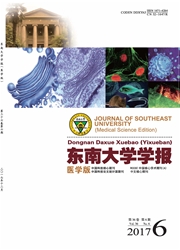

 中文摘要:
中文摘要:
目的:研究帕金森病中一氧化氮( NO)检测的新方法。方法:建立帕金森病的细胞与动物模型,检测小鼠相关行为学与生化指标的改变并通过新型探针MNIP-Cu荧光成像的方法检测NO浓度的变化。结果:帕金森病的细胞与动物模型中荧光探针MNIP-Cu检测到NO浓度显著升高,同时小鼠运动能力受到损伤、多巴胺合成减少;当NO合成受到抑制后,小鼠的运动能力和多巴胺的合成均显著恢复。荧光探针MNIP-Cu能够成功检测NO含量的变化。结论:新型荧光探针MNIP-Cu实现了对帕金森病体内外模型中NO的直接检测,为阐明NO在帕金森发病机制中的作用提供了新的研究手段。
 英文摘要:
英文摘要:
Objective:To develop a new method of nitric oxide detection in Parkinson disease .Methods:Using a Parkinson disease model in vitro and in vivo, we tested the behavior and biochemical changes of rat , and then detected the change of nitric oxide concentration through a novel fluorescent probe of MNIP-Cu.Results:The movement ability of rat was damaged with reduced dopamine synthesis in the Parkinson disease model .Consistently , the NO level was detected successfully by the MNIP-Cu fluorescence probe with significant increase .On the other hand, the rat's exercise capacity and dopamine production level was significantly restored after the inhibition of NO synthesis.Taking together, the NO production level can be detected successfully by the fluorescence probe of MNIP-Cu.Conclusion:We detect NO directly in Parkinson disease model in vitro and in vivo through novel fluorescent probe, which provides a new way to study the role of NO in the pathogenesis of the Parkinson disease.
 同期刊论文项目
同期刊论文项目
 同项目期刊论文
同项目期刊论文
 miR-141 Regulates colonic leukocytic trafficking by targeting CXCL12beta during murine colitis and h
miR-141 Regulates colonic leukocytic trafficking by targeting CXCL12beta during murine colitis and h Locally instilled tumor necrosis factor-alpha antisense oligonucleotide inhibits allergic inflammati
Locally instilled tumor necrosis factor-alpha antisense oligonucleotide inhibits allergic inflammati 3,3 '-Diindolymethane ameliorates adriamycin-induced cardiac fibrosis via activation of a BRCA1-depe
3,3 '-Diindolymethane ameliorates adriamycin-induced cardiac fibrosis via activation of a BRCA1-depe Knockdown of N-acetylglucosaminyl transferase V ameliorates hepatotoxin-induced liver fibrosis in mi
Knockdown of N-acetylglucosaminyl transferase V ameliorates hepatotoxin-induced liver fibrosis in mi MicroRNA-31 activates the RAS pathway and functions as an oncogenic MicroRNA in human colorectal can
MicroRNA-31 activates the RAS pathway and functions as an oncogenic MicroRNA in human colorectal can Low-molecular weight chitosan/vascular endothelial growth factor short hairpin RNA for the treatment
Low-molecular weight chitosan/vascular endothelial growth factor short hairpin RNA for the treatment A Microarray-based Approach Identifies ADP Ribosylation Factor-like Protein 2 as a Target of microRN
A Microarray-based Approach Identifies ADP Ribosylation Factor-like Protein 2 as a Target of microRN The auto-regulatory feedback loop of microRNA-21/Programmed cell death protein 4/Activation Protein-
The auto-regulatory feedback loop of microRNA-21/Programmed cell death protein 4/Activation Protein- miR-30 inhibits TGF-beta1-induced epithelial-to-mesenchymal transition in hepatocyte by targeting Sn
miR-30 inhibits TGF-beta1-induced epithelial-to-mesenchymal transition in hepatocyte by targeting Sn 3,3 '-Diindolylmethane alleviates oxazolone-induced colitis through Th2/Th17 suppression and Treg in
3,3 '-Diindolylmethane alleviates oxazolone-induced colitis through Th2/Th17 suppression and Treg in 期刊信息
期刊信息
